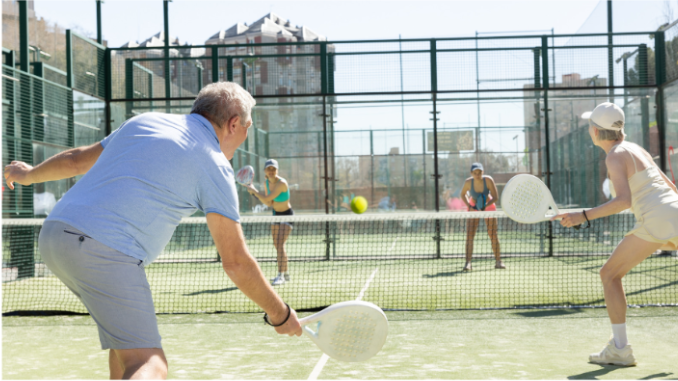Tennis, with its dynamic blend of strategy, athleticism, and precision, captivates enthusiasts of all ages and skill levels. Beyond being a wonderful way to strengthen the body, the sport also poses risks of injury if approached carelessly. However, with proper preparation and precautions, these risks can be effectively minimized. To ensure safer participation in tennis, remember the acronym “REST,” which outlines essential practices for injury prevention and optimal performance. Here’s a breakdown of what REST stands for:
Recovery: Before heading out to the court, ensure you are prepared for the recovery phases both during and after your match. Carry water to prevent dehydration and heat stroke. Older adults are more susceptible to heat strokes, so it is especially crucial for them to be prepared.1 On hot summer days, consider freezing water bottles that will melt into a refreshing, icy drink after a game. Make sure to also prepare an electrolyte-packed snack too. This can include nuts, bananas, coconut water, or even some cereals. They are not only delicious but also a great way to prevent cramps and support hydration.2
Equipment: Choosing the right tennis equipment is vital. Pay attention to your racket’s weight, length, and balance for optimal performance and injury prevention. Choose a racket that lets you more easily hit the “sweet spot” to not only up your game, but also prevent common injuries like tennis elbow. When it comes to injury prevention, it is also important to have the right footwear. While you can get away with regular shoes for a while, you should consider investing in a quality pair of tennis shoes made specifically for tennis to provide your feet ample lateral and torsional control to fend off plantar fasciitis, shin splints, and knee pain. A quick test you can do to a shoe is to give it a good twist. A stronger midsole will be more resistant to torsion.
Slow down: Tennis is fast-paced, but it’s essential to start gradually, especially if just starting or returning to the sport. Avoid long matches initially to allow muscles and bones to adapt. Remember that when you are on the court, it may be hard to hear when your body is telling you to stop, so take it slow when starting tennis or any other physical activity.
Technique: Tennis uses high-impact, repetitive motions. Proper technique is crucial to distribute stress evenly across the body to minimize strain on specific joints or muscles. Practicing good techniques involves training smooth and controlled muscle patterns that involve multiple parts of the body. Good technique also minimizes jerky movement and awkward positions that strain tendons and muscles. Being skilled in different techniques can also help alleviate the stress of repetitive motions. For example, training both forehand and backhand swings prevent overuse of one group of muscles.
REST: Lastly, remember to rest! Tennis is a great way to get exercise, which means your body is going through a lot while you are playing. Ideally, give yourself 2-3 days between tennis or other intense exercise activities for your body to heal so that you can get the most out of your next session safely.3
Tennis, when done correctly, is an excellent way to stay active. For additional guidance on staying safe during tennis or any physical activity, consider consulting a physical therapist to ensure you are physically prepared to play. In particular, our Live Your Life Fit & Quick for Sport program could be an excellent way to get all the benefits of a personal trainer and the expertise of a physical therapist. After your activities, prioritize recovery by consulting with a dietitian to ensure your body receives proper nourishment. Lastly, when all precautions have been taken, get out there, and get active!
Resources:
- Worfolk JB. Heat waves: their impact on the health of elders. Geriatr Nurs. 2000;21(2):70-77. doi:10.1067/mgn.2000.107131
- Lau WY, Kato H, Nosaka K. Water intake after dehydration makes muscles more susceptible to cramp but electrolytes reverse that effect [published correction appears in BMJ Open Sport Exerc Med. 2019 Apr 11;5(1):e000478corr1. doi: 10.1136/bmjsem-2018-000478corr1]. BMJ Open Sport Exerc Med. 2019;5(1):e000478. Published 2019 Mar 5. doi:10.1136/bmjsem-2018-000478
- Yang Y, Bay PB, Wang YR, Huang J, Teo HWJ, Goh J. Effects of Consecutive Versus Non-consecutive Days of Resistance Training on Strength, Body Composition, and Red Blood Cells. Front Physiol. 2018;9:725. Published 2018 Jun 18. doi:10.3389/fphys.2018.00725
What makes us different? Our care comes to you!
View Our Service AreaWe Are A Comprehensive Mobile Company Focused on Wellness, Fitness, Rehabilitation, and Prevention
We specialize in transforming the lives of seniors, adults and teenagers with a wide array of diagnoses and conditions in their home or location of choice. You deserve to be your best self through good health and wellness. We would love to have the privilege to work with you or a loved one.
Request a FREE Consultation Today!
